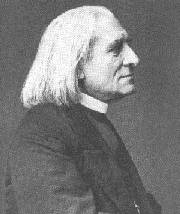 (born
Raiding, 22 October 1811; died Bayreuth, 31 July 1886).
(born
Raiding, 22 October 1811; died Bayreuth, 31 July 1886).
He was taught the piano by his father and then Czerny (Vienna, 1822-3), establishing himself as a remarkable concert artist by the age of 12. In Paris he studied theory and composition with Reicha and Paer; he wrote an opera and bravura piano pieces and undertook tours in France, Switzerland and England before ill-health and religious doubt made him reassess his career. Intellectual growth came through literature, and the urge to create through hearing opera and especially Paganini, whose spectacular effects Liszt eagerly transferred to the piano in original works and operatic fantasias. Meanwhile he gave lessons and began his stormy relationship (1833-44) with the (married) Countess Marie d'Agoult. They lived in Switzerland and Italy and had three children.
He gave concerts in Paris, maintaining his legendary reputation, and published some essays, but was active chiefly as a composer ("Annees de pèlerinage"). To help raise funds for the Bonn Beethoven monument, he resumed the life of a travelling virtuoso (1839-47); he was adulated everywhere, from Ireland to Turkey, Portugal to Russia. In 1848 he took up a full-time conducting post at the Weimar court, where, living with the Princess Carolyne Sayn-Wittgenstein, he wrote or revised most of the major works for which he is known, conducted new operas by Wagner, Berlioz and Verdi and, as the teacher of Hans von Bülow and others in the German avant-garde, became the figurehead of the 'New German school'. In 1861-9 he lived mainly in Rome, writing religious works (he took minor orders in 1865); from 1870 he journeyed regularly between Rome, Weimar and Budapest. He remained active as a teacher and performer to the end of his life.
Liszt's personality appears contradictory in its combination of romantic abstraction and otherworldliness with a cynical diabolism and elegant, worldly manners. But though he had a restless intellect, he also was ceaselessly creative, seeking the new in music. He helped others generously, as conductor, arranger, pianist or writer, and took artistic and personal risks in doing so. The greatest pianist of his time, he composed some of the most difficult piano music ever written (e.g. the "Transcendental Studies") and had an extraordinarily broad repertory, from Scarlatti onwards; he invented the modern piano recital.
Two formal traits give Liszt's compositions a personal stamp: experiment with large-scale structures (extending traditional sonata form, unifying multi-movement works), and thematic transformation, or subjecting a single short idea to changes of mode, rhythm, metre, tempo or accompaniment to form the thematic basis of an entire work (as in "Les préludes", the "Faust-Symphonie"). His 'transcendental' piano technique was similarly imaginative, springing from a desire to make the piano sound like an orchestra or as rich in scope as one. In harmony he ventured well beyond the use of augmented and diminished chords and the whole-tone scale; the late piano and choral works especially contain tonal dashes arising from independent contrapuntal strands, chords built from 4ths or 5ths, and a strikingly advanced chromaticism.
Piano works naturally make up the greater part of Liszt's output: they range from the brilliant early studies and lyric nature pieces of the first set of "Annees de pèlerinage" to the finely dramatic and logical B Minor Sonata, a masterpiece of 19th-century piano literature. The piano works from the 1870s onwards are more austere and withdrawn, some of them impressionistic, even gloomy ("Anneés", third set). Not all the piano music is free of bombast but among the arrangements, the symphonic transcriptions (notably of Berlioz, Beethoven and Schubert) are often faithful and ingenious, the operatic fantasias (on "Norma" and "Ernani", for example) more than mere salon pieces.
Liszt invented the term 'sinfonische Dichtung' ('symphonic poem') for orchestral works that did not obey traditional forms strictly and were based generally on a literary or pictorial idea. Whether first conceived as overtures (Les préludes) or as works for other media (Mazeppa), these pieces all emphasize musical construction much more than scene-painting or story-telling. The three-movement "Faust Symphonie" too, with its vivid character studies of Faust, Gretchen and Mephistopheles, relies on technical artifice (especially thematic transformation) more than musical narrative to convey its message; it is often considered Liszt's supreme masterpiece. Although he failed in his aim to revolutionize liturgical music, Liszt did create in his psalm settings, "Missa solemnis" and the oratorio "Christus" some intensely dramatic and moving choral music, successful in his lifetime and well suited to concert performance.
Liszt made numerous contributions to musical literature as a critic, as a commentator on the current musical scene, and as a champion of the "modern" style of his day. He wrote a series of articles, "Zur Stellung des Künstlers" (On the Position of Artists, 1835), in which he discussed the social consciousness of composers and performers. He wrote on church music, calling for a return to the function of music as a spiritual force.